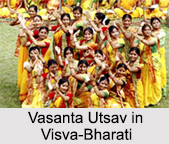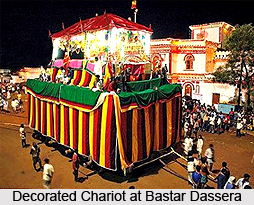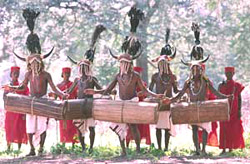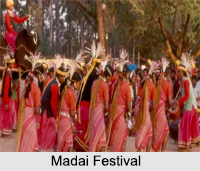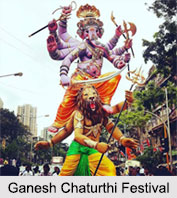 Maharashtra Temple Festivals are celebrated all across the state with happiness and fervour. The Maharashtrians are vibrant, vivacious people who love celebrations at any occasions. Any religious ritual is manifested in form of festivals in Maharashtra. Maharashtra is a land of prosperous cultural inheritance and traditions. The varied form of landscape and environment make the state`s culture more colourful. Maharashtrians celebrate every fair with great fervour and enthusiasm. Maharashtra is a land of temples.
Maharashtra Temple Festivals are celebrated all across the state with happiness and fervour. The Maharashtrians are vibrant, vivacious people who love celebrations at any occasions. Any religious ritual is manifested in form of festivals in Maharashtra. Maharashtra is a land of prosperous cultural inheritance and traditions. The varied form of landscape and environment make the state`s culture more colourful. Maharashtrians celebrate every fair with great fervour and enthusiasm. Maharashtra is a land of temples.
Maharashtra temple festivals are celebrated with abundant fervour and enthusiasm. The temple festivals of Maharashtra are a true reflection of Maharashtrian culture, with all its colourful customs, rituals and religious traditions. The song, music and dance accompany almost every festive occasion in the temples and add joy and excitement to the lives of the people from every walk of life. The Maharashtra temple festivals are a compliment to the state"s rich culture and legacy.
Some of the famous temple festivals of Maharashtra are as follows:
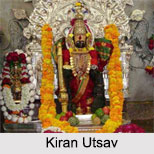 Ganesh Chaturthi: Maharashtrians have large faith on Lord Ganesh, Ganesh Utsav at Sangli and Pune are the fairs that Maharashtrians celebrate with great excitement. The festival is attended by the greatest number of visitors even from overseas countries. It regarded as one of the most significant festival of the Maharashtra area. It is a carnival of seven to ten days. Detailed arrangements are made for lighting and ornamentation and Ganeshji is enthusiastically worshipped for those seven to ten days.
Ganesh Chaturthi: Maharashtrians have large faith on Lord Ganesh, Ganesh Utsav at Sangli and Pune are the fairs that Maharashtrians celebrate with great excitement. The festival is attended by the greatest number of visitors even from overseas countries. It regarded as one of the most significant festival of the Maharashtra area. It is a carnival of seven to ten days. Detailed arrangements are made for lighting and ornamentation and Ganeshji is enthusiastically worshipped for those seven to ten days.
Kiran Utsav: The Mahalaxmi Temple is pleasingly decorated for Kiran Utsav. Kiran Utsav is one of the well-liked festivals in India. It is organized at Mahalaxmi Temple of Kolhapur district in Maharashtra on 31st January, 1st February, and 9th, 10th, and 11th November every year. Goddess Lakshmi is worshipped through this celebration.
Thimithi: Crowds pack the Sri Mariamman Temple on South Bridge road for this festival. Thimithi is the name of the annual Hindu fire walking ritual which is a form of self-punishment or blessing in tribute to the goddess Draupadi, idol of the epic poem, the Mahabharata.
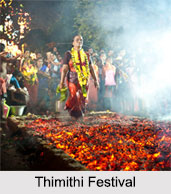 Shrirama Rathotsava Fair: Shrirama Rathotsava Mandir, which belongs to the Peshwa era, is located near Jalgaon, Maharashtra. Shrirama Rathotsava Fair is celebrated yearly in this temple between October and November months to give an extraordinary worship to the deities. Images of Rama, Laxmana and Sita are carried in a palanquin to the Girna River for a bath on the event day. The images are then decorated with ornaments and garlands.
Shrirama Rathotsava Fair: Shrirama Rathotsava Mandir, which belongs to the Peshwa era, is located near Jalgaon, Maharashtra. Shrirama Rathotsava Fair is celebrated yearly in this temple between October and November months to give an extraordinary worship to the deities. Images of Rama, Laxmana and Sita are carried in a palanquin to the Girna River for a bath on the event day. The images are then decorated with ornaments and garlands.
Gudhi Padwa: Gudhi Padwa is a religious ritual in Maharashtra that marks the victory symbol-characterized by a bamboo stick with a coloured silk cloth and garlanded with flowers and sweets atop. This festival is celebrated during the New Year and the people welcome the year by worshipping the gudhi and distribute prasad comprising tender neem leaves, gram-pulse and jaggery. Narali Poornima festival is held on full moon day of the month of Shravan. This day is also famous in Maharashtra as Raksha Bandhan. People make offerings of coconuts to the sea-god on this day, thus marking the advent of the new fishing season and fishermen appease the sea-god before sailing out in their gaily-decorated boats. Singing and dancing make the day. Sisters tie `rakhis` or beautifully decorated threads on their brothers` wrists and thus renew the bond of affection between siblings.
Gokul Ashtami: The dawn of Lord Krishna is celebrated on Gokul Ashtami or Janmashtami. Most devotees fast till the birth of Lord Krishna is announced. Gopal Kala-a preparation made of compressed rice and curd is prepared on this day. Another fun-filled ceremony performed on this day is dahi-handi - clay pots filled with curd, puffed rice and milk are strung high up above the streets and groups of excited young men (and even women) form human pyramids to reach these and break them open, the way Lord Krishna and his friends would, after nagging into the houses of gopis (milkmaids) to steal and have butter.
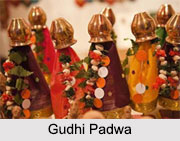 Diwali is the most beautiful of all Maharashtra temple festivals. All the temples are decorated with lights of different colours and innumerable diyas. Streets are also illuminated with rows of clay lamps and homes are decorated with rangoli and aakash kandils. People offer Puja in temples with deities like Ganesh and Lakshmi; they rise at dawn, massage their bodies and hair with scented oil and aromatic powders-uttana and take a holy bath. Diwali is celebrated with spectacular firecrackers and exchange of a variety of sweets in the company of family and friends.
Diwali is the most beautiful of all Maharashtra temple festivals. All the temples are decorated with lights of different colours and innumerable diyas. Streets are also illuminated with rows of clay lamps and homes are decorated with rangoli and aakash kandils. People offer Puja in temples with deities like Ganesh and Lakshmi; they rise at dawn, massage their bodies and hair with scented oil and aromatic powders-uttana and take a holy bath. Diwali is celebrated with spectacular firecrackers and exchange of a variety of sweets in the company of family and friends.
Makar Sankranti is another Maharashtra Temple Festival, where people exchange greeting and good wishes on this day. Sweet and crunchy ladoos are made of sesame and jaggery called "TilGul".
Nag Panchami is performed as a Maharashtra Temple Festival in different sacred sites of the state. This festival is celebrated in the honour of the Snake God Shesha Nag. Snake worship is an essential ritual of the Maharashtrians, and on the festival of Nag Panchami, clay icons of cobras are venerated in temples and homes. People offer sweets and milk to the snake deity and the snake charmers carry cobras in baskets and collect offerings from the public in the streets. Women apply mehendi on their hands and the day is celebrated with dances and songs.

